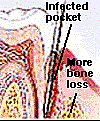    
|
Periodontal
disease is a complex problem which is finally being understood. The mouth
harbors many kinds of bacteria. Certain types of these organisms form gummy
colonies which are known as dental plaque. No mouth is free of plaque, but it
can be minimized if effective oral hygiene habits are introduced on a daily
basis. Plaque re-forms within 24 hours and, if allowed to build-up, becomes a
whitish coating on the teeth.
Plaque causes the
breakdown of gum tissue and it also releases enzymes, some of which destroy
enamel and lead to cavities. The bacterial action also breaks down the fibrous
connective tissue around the tooth, causing the formation of periodontal
pockets, which also harbor colonies of bacteria. The gums become inflamed and
the pockets become deeper. This process may or may not be accompanied by
recession. At this point the jaw bone in which the teeth are held begins to
erode. The process is called bone resorption and may result in a loosening of
the involved teeth. If left untreated, it may result in the eventual loss of
teeth.

Periodontal pockets are an indicators of
periodontal disease. The levels of the disease must be considered on an
individual basis in order to determine an appropriate course of treatment.
These levels are usually classified as early, moderate, or advanced. In
moderate or advanced cases, there is often the need to go to a Periodontist,
which is a dentist who has specialized training in the area of gum disease, and
often times periodontal surgery is needed in order to remove the periodontal
pockets and refine any eroded areas.
In early to
moderate periodontal disease, soft tissue management (STM) is recommended. This
involves a series of appointments consisting of "deep cleaning" on the tooth
surface and around and below the gum line to remove the plaque and attempt to
get the periodontal disease under control. The STM program also requires
cooperation in continuing with follow up maintenance visits which may be
recommended as often as every three months, but no greater than six months. It
is important that the periodontal disease be monitored closely. STM does not,
in any way, preclude the possibility of surgical or other procedures that might
still require the special abilities of a periodontist.
The
STM program is a means by which general dentists and periodontist can work
closely together if needed in order to serve the best interest of the patient.
Effective home care is a very important part of periodontal therapy. Proper
brushing, flossing, and use of antibiotic mouthwashes are recommended along
with the Roto-dent toothbrush which has been proven effective in plaque control
and periodontal disease. |

